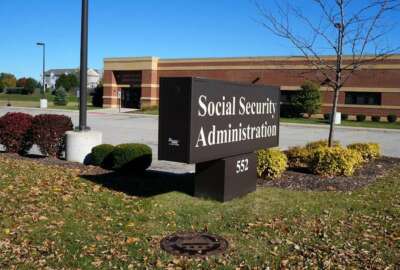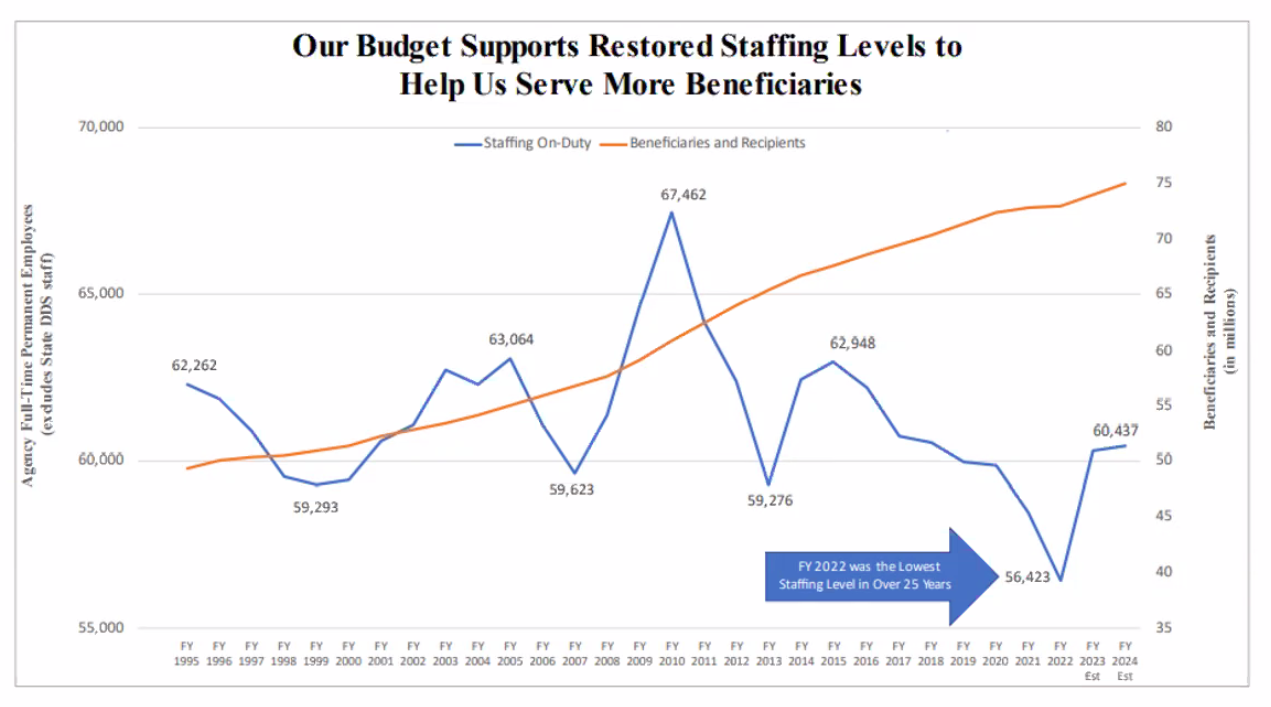
Unions ‘sound the alarm’ over worsening staff attrition at SSA
Stressful work conditions are causing severe burnout among SSA employees, leading to high attrition rates and growing workloads for employees who remain with the...
Editor’s note: This story has been updated with comments from the Social Security Administration.
Poor work-life balance. Insufficient pay. Unmanageable workloads. Few opportunities for teleworking.
The challenges for the Social Security Administration’s workforce are virtually unending, and if SSA leadership doesn’t change course soon, the agency’s metaphorical ship could capsize, the American Federation of Government Employees said.
“We are here today to sound the alarm,” said Jessica LaPointe, president of AFGE Council 220, during an AFGE press conference Monday.
Stressful work conditions are causing severe burnout among SSA field office employees, AFGE said, in turn leading to high staff attrition rates and growing workloads for the SSA employees who remain with the agency.
“The situation we’re seeing right now is roughly akin to a patient bleeding out and the doctor administering one blood transfusion after the next without closing the wound first. All that we’re doing is suffering yet more blood loss,” said Rich Couture, president of AFGE Council 215, representing SSA field office employees.
Nine out of 10 SSA employees in a union-conducted survey said they know someone who has left their job due to “overwhelmingly large amounts of work-related stress,” LaPointe said. The same survey from AFGE reported that 54% are looking to leave the agency within the next year, and 52% want to leave because of low pay.
More than three-quarters of survey respondents said massive workloads prevent them from performing their jobs to the best of their ability.
In extreme cases, 8% of respondents said they know an SSA employee who has taken their own life due to work-related stress.
In recent years, SSA has been “consistently in the basement” in the Partnership for Public Service’s Best Places to Work in the Federal Government rankings, Couture said. That’s in stark contrast to 2011, when SSA secured the number two spot for large agencies.
The Partnership’s 2022 rankings put SSA in last place for large agencies, with an employee engagement and satisfaction score of 53.9 out of 100. That’s a 6-point drop since the agency’s 2021 score. In contrast, the agency’s highest ever employee engagement and satisfaction score was 71.6 in 2010.
Low staffing numbers are both the cause of — and contributing to — negative experiences of many SSA employees. Hiring at the agency is down by 50% since 2010, LaPointe said. In fiscal 2022, SSA had its lowest staffing numbers in over 25 years. But as staffing declines, the number of beneficiaries continues to climb, leading to bigger workloads for employees.

With what AFGE said is a lack of competitive pay and benefits, SSA lost almost 4,500 bargaining unit employees in fiscal 2022 — over 10% of AFGE’s total membership for SSA.
“We suspect that the overall attrition rate is probably higher,” Couture said. “Unless SSA gets serious, it’s going to have problems with both retention and recruitment … The agency can say all of these nice words about how much it appreciates the sacrifice, the commitment, the dedication of our workers, but its actions to date have not been consistent with those words. Until that happens, things are going to continue to get worse.”
SSA spokesperson Mark Hinkle said agency management agreed that sufficient staff is necessary to handle the growing workloads and reduce backlogs, adding that SSA Acting Commissioner Kilolo Kijakazi has made hiring a “critical focus” for the entire agency. But to hire essential staff, Hinkle said the agency needs more funding.
“Our employees are dedicated to providing timely, accurate and respectful service to the millions of people who turn to us for assistance each year. Sufficient and sustained funding from Congress is critical to providing quality service,” Hinkle said in an email.
For fiscal 2023, SSA’s operating budget is $14.1 billion, an increase of $785 million above the agency’s fiscal 2022 budget. The 2023 enacted budget for SSA is 55% of the White House’s budget request for the agency.
SSA is “using the funding increase to restore staffing from the lowest levels in over 25 years, particularly in our field offices, teleservice centers, processing centers and state Disability Determination Services. We are replacing our staffing losses during the year while adding about 4,000 SSA employees,” Hinkle said.
Employee attrition is also lower this year than at this point last year, he added.
SSA’s public-facing services are also rapidly worsening, AFGE said. Wait times average more than 30 minutes before a caller can speak with an SSA representative. Nearly half of all calls go unanswered due to busy signals or callers getting frustrated and hanging up. The backlog of disability claims is over 1 million, 60% above the backlog in 2019. The time to process disability claims increased from 79 days in fiscal 2019 to 214 days in fiscal 2022.
SSA has received repeated criticism from House Republicans, who have pointed to the agency as a prime example where telework is causing significant backlogs and delays in federal agencies’ public-facing services. But Democrats and many federal unions have said underfunding and understaffing are the root cause of SSA’s service issues, not telework.
The solution is straightforward, Couture said: Invest in the workforce you already have, and use direct hire authority to add new employees more quickly.
The Office of Personnel Management gave SSA the special authority to try to improve the hiring speed for new employees in public-facing service positions, Hinkle said.
But simply bringing new employees on board isn’t nearly enough to fix the burdensome workloads at the agency, AFGE said. It takes two to three years for a new SSA employee to become fully trained in the agency’s complex systems and processes. Many new hires leave within the first year on the job.
“If you replace them even one for one with new employees, those employees don’t have the same experience. They’re learning — they’re not going to be as fast. Our programs are complex. The more you do it, the more you become proficient at it, the faster you get at being able to maneuver the systems, being able to make decisions on those claims,” said Angela DiGeronimo, a regional vice president for AFGE Council 220, during the press conference. “We are not going to fix this immediately, however, if we don’t start dealing with the crisis and addressing the fact that we are severely understaffed, we will not get to the point where we can fix this problem going into the future.”
“We have focused our efforts on improving training, development and support for employees,” Hinkle said.
“We are suffering everywhere”
It’s not only field office employees who are struggling. Employees in other departments, including attorneys, human resources staff and administrative law judges (ALJs), face equally daunting workloads and stress levels.
“We are suffering everywhere,” LaPointe said.
In the Office of Hearings Operations (OHO) at SSA, ALJs and other staff members feel pressure mounting as workloads grow. One particularly acute issue is the judge-to-staff ratio, said Som Ramrup, president of the Association of Administrative Law Judges, the federal union representing the agency’s ALJs.
The current judge-to-staff ratio is 1.90, meaning there are on average fewer than two staff members for every ALJ in SSA. In some offices, the ratio is worse. In St. Louis, Missouri, for instance, the judge-to-staff ratio is 1.21.
The agency has previously told the SSA Office of Inspector General that the goal for that ratio is between 2.65 and 2.75.
“Even when they’ve been able to hire staff, the staff quit several days later, because they’re so overwhelmed,” Ramrup, an administrative law judge in New York City and an SSA employee for more than 20 years, said in an interview. “You can’t function in such an environment.”
“They’re just bleeding staff at this point,” Ramrup added.
Limited opportunities for promotion
The National Treasury Employees Union said OHO has faced staff attrition as well, losing about 450 employees in the past couple of years. NTEU represents attorneys and paralegals that work in OHO, totaling about 1,500 attorneys and 75 staff members in the union.
The small handful of opportunities for promotion for SSA attorneys, who are in the excepted service, makes retention all the more difficult, said Christie Saunders, president of NTEU Chapter 224.
“We need more permanent career advancement opportunities to retain our skilled attorneys,” Saunders said in an email.
In one positive, NTEU has recently negotiated a “maxiflex” schedule for OHO employees. The schedule allows for more flexible work hours, which promotes work-life balance, Saunders said.
“We also pursued a student loan repayment program, which other agencies implemented years ago,” Saunders said. “However, SSA told us they did not have a recruitment and retention problem, and they refused to negotiate.”
SSA spokesperson Hinkle said the agency has reached “mutually beneficial solutions” through good faith bargaining between unions and management.
“We were one of the first federal agencies to reach agreements with all our unions on resuming in-person service in our offices in April 2022,” Hinkle said in an email. ”We have reached 47 mid-term agreements with our labor unions, and we secured collective bargaining agreements with two of our unions and will begin a partial renegotiation with our third, AFGE, next week.”
Although certainly not unique, two areas where Saunders said SSA still falls short are competitive pay and telework opportunities.
“[Telework] is within SSA’s control, but they have been reluctant to address it,” Saunders said. “While the Biden administration has encouraged agencies to increase telework and consider remote work programs, SSA refuses to discuss the future of telework with us. SSA continues to provide vague comments about how successful we have been with the current telework levels. They pat us on the back and tell us we have done a great job, however, refuse to make any concrete promises.”
Future of SSA funding
The funding SSA received in fiscal 2023 was “negligible” after taking inflation into account, AFGE said. For fiscal 2024, the Biden administration’s budget request includes roughly $15.5 billion for SSA.
“That’s the absolute bare minimum that Congress needs to approve for SSA,” said Linda Benesch, communications director at Social Security Works, an advocacy group for SSA employees, during the press conference.
Taking into account historically low staffing levels, AALJ’s Ramrup said the White House’s budget request for SSA is “insufficient.”
“The head count is well below where it’s been in the past and the work only continues to pile up,” Ramrup said. “There needs to be better support for the people that they are hiring and that’s not just about getting the funding to hire people. You have to be able to develop a program to ensure that you’re going to retain these people.”
But SSA spokesperson Hinkle said the funding would be critical to address the current conditions for SSA’s workforce.
“Even with incredible efforts from Social Security employees, we need the President’s full fiscal 2024 budget request to improve service,” Hinkle said.
Alternatively, AFGE recommended a budget of about $17.5 billion for SSA for 2024, roughly $2 billion above the White House’s request.
Within the union’s budget recommendation, AFGE said 56% — $9.62 billion — would go toward salary and benefits for employees. About 16% would fund improvements for equipment, security and more. Another 17% would fund the agency’s Disability Determination Services (DDS) and 11% would go toward IT improvements.
To be able to address the numerous workforce challenges, one area of concern was the lack of a nomination from the President for a permanent commissioner to helm the agency.
But Couture said management shouldn’t wait for the nomination to start making changes — many of these workforce challenges can be addressed immediately.
“We need leadership to step up — to not just hear their employees, but to listen to them, and to take concrete radical action to solve these problems, stop the bleeding and begin to turn the agency around,” Couture said. “I don’t see the acting designation as a barrier to getting this done, because we have seen acting commissioners in the past do just that.”
Copyright © 2025 Federal News Network. All rights reserved. This website is not intended for users located within the European Economic Area.
Drew Friedman is a workforce, pay and benefits reporter for Federal News Network.
Follow @dfriedmanWFED




